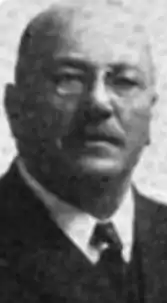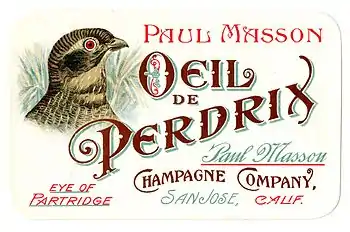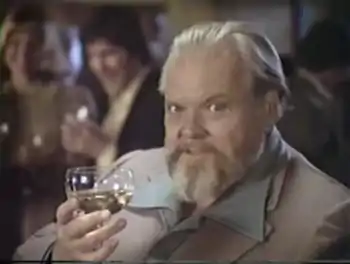Paul Masson
Paul Masson (1859 – October 22, 1940) was an early pioneer of California viticulture and successful popularizer of Californian sparkling wine.
Paul Masson | |
|---|---|
 | |
| Born | 1859 Burgundy, France |
| Died | (aged 82) San Jose, California |
| Occupation | Viticulturist |
| Political party | Republican |
| Spouse(s) | Louise Lefranc
(m. 1888; died 1936) |
Biography
Masson emigrated from the Burgundy region of France in 1878 (at the age of 19) to California, United States, where he met Charles Lefranc (owner of the Almaden Vineyard and Wine Company), one of a number of French immigrants who had expanded the viticulture introduced into the Santa Clara Valley by the Catholic mission fathers. Masson went back to France in 1880 to finish school at The Sorbonne. After college he returned to San Jose, California due to the depression in the French wine industry caused by the Phylloxera plague and became the winemaker at Almaden. After the death of Lefranc, Paul purchased 573 acres in Saratoga, California, which he named La Cresta. He set about to plant 60 acres, mainly Pinot Noir and Chardonnay with cuttings from Burgundy and re-named the new winery the Paul Masson Champagne Company, now known as The Mountain Winery. According to the Paul Masson company web site, in 1892 Masson's first sparkling wine under the name "champagne" was introduced at Almaden, and Masson eventually became known as the "Champagne King of California" after winning at the Paris Expo in 1900.
He was appointed to California's Board of State Viticultural Commissioners on August 30, 1913.[1]
Masson died at his home in San Jose on October 22, 1940, and is buried at Oak Hill Memorial Park.[2]
Winery

Masson shifted part of his production to the Santa Cruz Mountains above Saratoga, California and built his "chateau" on a knob overlooking the Santa Clara Valley in 1905. Now known as "The Mountain Winery", the Paul Masson Mountain Winery is on the National Park Service's National Register of Historic Places, though it ceased making wines in 1952. Instead, it serves as a conferencing and events venue - various events are held at the winery, such as concert series, weddings, and other special events. A famous chess tournament was held there annually for a number of years in the late 1970s and early 1980s.[3] Around 2000, the then-current owners of the site hired winemaker Jeffrey Patterson to restart winemaking on site. The vineyards were reestablished at the Mountain Winery in 2004.[4]
Advertising

The Paul Masson brand is best remembered for its 1978-1981 marketing association with actor-director Orson Welles, who promised for Masson: "We will sell no wine before its time."[5] An infamous, widely circulated and much-parodied outtake for one commercial from the campaign features Welles attempting to deliver his lines while severely inebriated.[6] Welles was eventually fired as a spokesman for the brand in 1981, after answering a question about Paul Masson on a TV chat show, saying that he was now on a diet and so no longer drank wine; he was (briefly) replaced as spokesman by John Gielgud.[7]:225
Despite the ads' success at the time, the Paul Masson brand has suffered from a long-term image problem, particularly since its founder's death in 1940, in being synonymous with low-end wines. As The New York Times observed in 1990: "While many consumers know them - who can forget Orson Welles's breathy incantation of 'We will sell no wine before its time' for Masson - they lack cachet."[8]
Paul Masson and NASA
In the 1970s NASA bought Masson Rare Cream Sherry for a Skylab mission and packaged some for testing on a "zero-G" aircraft. Unfortunately, the smell quickly permeated the cabin making astronauts physically sick, and public pressure over taking alcohol into space led NASA to abandon their plans.[9]
Ownership
After the death of his wife, Louise Lefranc, Masson put the winery up for sale. Mentored by Paul Masson, Martin Ray (a pioneer, dedicated to crafting single varietal, region-specific wine from 1943 through 1972 in Saratoga, in the heart of the Santa Cruz Mountains), purchased the winery and vineyards. Six years later, Martin Ray sold The Paul Masson winery and brand to The Seagram Company, Ltd, the global wine and spirits company (along with minority share owners). In the 1980s, Seagram also acquired the Taylor California Cellars brand (and production facilities) from Coca-Cola, based on the premise promoted by Seagram's strategic planning head, Mary Cunningham, that the only way to succeed in the wine business was to approach Gallo's massive sales volume. Over the next twenty years, the wine industry would dramatically segment itself with, essentially, all the large volume brands falling by the wayside. Internal competition and resulting cannibalization dramatically reduced the combined sales of Paul Masson and Taylor (as it did with Almaden and Inglenook, also owned by a single parent company).[8]
These changes resulted in the Paul Masson brand being sold to Vintners International in 1987.[8]
Vintners was in turn purchased by the Centera Wine Company (formerly "Canandaigua") of New York in 1993, as part of Vintner's bankruptcy proceedings.[10] Canandaigua was then renamed Constellation Brands in 2000.
In 2008, Wine Group LLC of San Francisco purchased the Paul Masson winery, which had ceased making wine in 1952, and now serves as a conferencing and events center. Wine Group LLC subsequently removed the Paul Masson name and renamed it "The Mountain Winery". Wine Group LLC also purchased two California wine brands from Constellation Brands, including the Paul Masson table wine range, currently consisting of three types of bottle sold - white, red, and rosé, made from grapes grown elsewhere in California. Meanwhile, Constellation Brands in New York continues to manufacture and sell the profitable Paul Masson brandies.[11]
References
- California Blue Book. California Secretary of State. 1915. p. 493. Retrieved July 6, 2020 – via Google Books.
- "Paul Masson, Famous Wine Grower, Dies". San Francisco Examiner. San Jose. October 23, 1940. p. 32. Retrieved July 6, 2020 – via Newspapers.com.
- Paul Masson Mountain Winery National Park Service. Retrieved from on 2004-12-28
- "The History and Legacy of Our Estate". mountainwinery.com. Retrieved August 11, 2017.
- "Orson Welles for Paul Masson". YouTube. Darian Glover. 1980. Retrieved February 12, 2017.
- "Original Takes for Orson Welles Wine Commercial". YouTube. grimscribe126. 1980. Retrieved February 12, 2017.
- McBride, Joseph (2006). Whatever Happened to Orson Welles? A Portrait of an Independent Career. Lexington, Kentucky: The University Press of Kentucky. ISBN 978-0813124100.
- Lawrence M. Fisher (May 12, 1990). "A Troubled Winery Where Debt Is Aging". New York Times. Retrieved November 13, 2007.
- Ross-Nazzal, Jennifer (April 7, 2006). "Edited Oral History Transcript - Charles T. Bourland". NASA Johnson Space Center Oral History Project.
- Lawrence M. Fisher (September 16, 1993). "Canandaigua to Acquire Vintners". New York Times. Retrieved November 13, 2007.
- Wine Group buys Almaden, Inglenook brands, Paul Masson winery, for $134M San Francisco Business Times